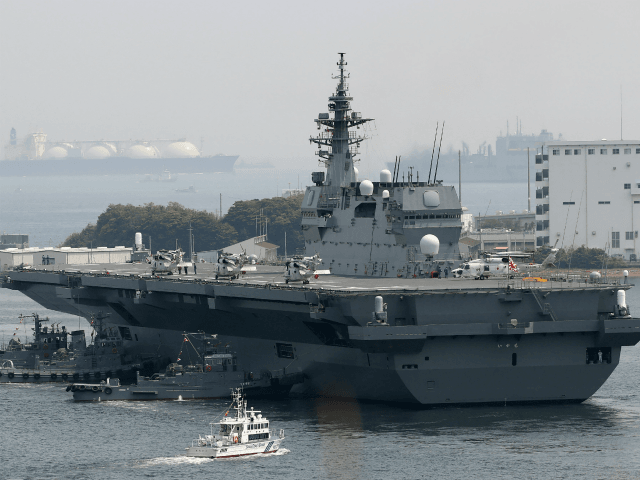The Japanese government announced on Tuesday that it will deploy aircraft carriers for the first time since World War II as part of a defense strategy that will involve purchasing a great deal of American military hardware, a course of action U.S. President Donald Trump has strongly urged.
Japan’s aircraft carriers will be the 27,000-ton JS Izumo and Kaga, which currently serve as helicopter carriers. The military will refit the ships to launch U.S.-made F-35B jet fighters, which require very little runway space for takeoff and can land vertically, a capability known as “short takeoff/vertical landing” or STOVL.
The Defense Ministry stressed that Izumo and Kaga will not carry fighter jets at all times, only when they are needed to deal with particular security situations. Each ship will be able to carry about a dozen F-35bs, less than one-fifth the strike power carried by current U.S. aircraft carriers and considerably smaller than even the more modest carriers fielded by some other navies.
As Defense Minister Takeshi Iwaya put it, the goal is to “increase their applications” rather than converting the ships into power-projection platforms on par with U.S. aircraft carriers – or, more to the point, China’s new aircraft carriers.
The South China Morning Post quoted concerns from Japanese opposition politicians and some international observers that China will overreact to Japan’s carrier announcement, no matter how hard Tokyo strives to portray the ships as small multipurpose platforms, and use the Japanese carriers as an excuse to ramp up military spending.
One such observer was Hong Kong-based analyst Song Zhongping, who joined many Chinese (and some other Asians, including pacifist Japanese) in viewing Japan’s announcement as the Empire of the Rising Sun clawing its way from the grave of World War Two to menace the Pacific again:
“Japan has so far refused to recognize its aggression against China during the second world war,” he said. “Any move to build its first aircraft carrier would not only violate its pacifist constitution – which forbids it from operating such an attack vessel – but would also make China and other countries that were victims of its aggression very uneasy.”
The plan was “obviously targeting China”, Song said as Beijing had accelerated its own naval build up with the addition of advanced destroyers and aircraft carriers.
Beijing has made significant advances in its naval firepower in recent years. It already has one aircraft carrier – the Liaoning – in active service, and a second – the domestically developed Type 001A – is set to join it next year. By 2030, at least four aircraft carrier battle groups are expected to be in service.
Another Chinese analyst quoted by the SCMP, Zhou Chenming of Beijing, reasonably pointed out that Japan’s two tiny part-time aircraft carriers would be no match for the four full carrier battle groups China plans to deploy.
These details will not mollify opportunistic Chinese politicians or pacifist Japanese, who are deeply philosophically opposed to developing an offensive military capability. Japan’s increasingly influential Buddhist minority party, Komeito, is especially committed to this point.
From a strategic perspective, Japan’s carriers are significant to China because they would make it much easier for Japan to respond to anything less provocative than a full Chinese carrier deployment. The Japanese ships would take low-level mischief off the table, giving Japan eyes and response capabilities across a region China would prefer to keep murky and remote for the time being. China would have a much harder time blocking Japanese civilian vessels from accessing disputed islands.
From a psychological standpoint, the notion of Japan putting aircraft carriers at sea again has a significance across Asia that might be difficult for Westerners to appreciate, especially when looking at comparisons between the Izumo and USS Nimitz, for example. Asia is not really over World War II and technically World War II is not really over, as can be seen from Japan’s reaction to new Russian military bases on disputed islands whose disposition has prevented those two nations from signing a full peace treaty for 70 years.
U.S. approval for Japan’s ten-year defense plan is important and the Trump administration will surely be pleased with Japan’s plans to buy dozens of F-35 jets and other American military hardware.
The Wall Street Journal noted on Tuesday that “Tokyo’s decision to spend more on U.S. military equipment comes as Mr. Trump has called for Japan to spend ‘massive amounts’ on American defense products to lower its trade surplus with the U.S.” The F-35s will cost around $10 billion, while Japan’s defense buildup will cost a total of $242 billion over the next five years, a substantial increase over the $218 billion spent over the previous five years.
This represents a record high in military spending by modern Japan, with a great deal of funding allocated for missile defense and cybersecurity in addition to air and naval upgrades.

COMMENTS
Please let us know if you're having issues with commenting.